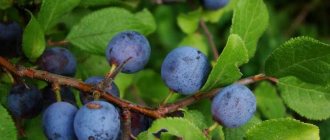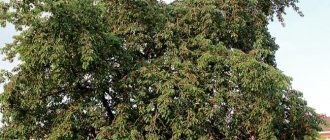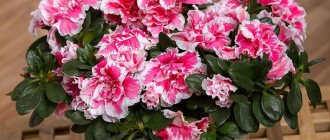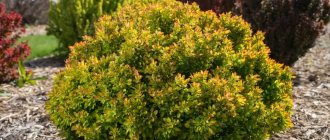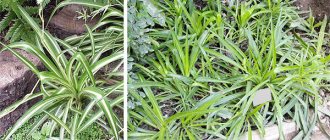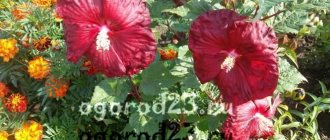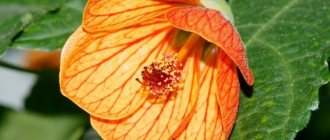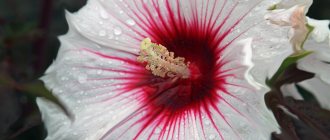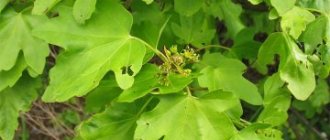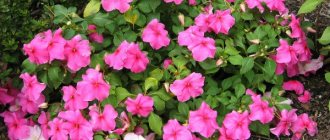Syrian tree hibiscus belongs to the Malvaceae family, is a beautiful exotic plant that is successfully grown both indoors and in the garden.
In total there are about 300 different varieties of Syrian rose .
The perennial in its natural habitat (Indonesia, China) prefers a subtropical climate, but adapts well to our difficult conditions.
It can be found in the southern regions of Russia and in the Moscow region, on the Crimean Peninsula, in Belarus and Ukraine .
Appearance of Syrian hibiscus
Syrian hibiscus (Hibiscus) is a plant from the Malvaceae family; its second name is garden (street) rose or Sharon. Syrian hibiscus (you will see the photo below) is a tree-like shrub with a height of 2 to 6 meters, depending on the variety. The stem is thick, has a tree-like shape, the branches are erect, not branching.
The flower has green, ovoid, medium-sized leaves with jagged edges. Hibiscus blooms with beautiful single simple and double flowers. Flowers can be of different colors: from white to crimson, sometimes bicolor.
Plant varieties:
- Brabant is a large hibiscus that reaches a height of 2 m and a width of 1.5 m. It blooms with large, densely double flowers with a diameter of 15 cm. It has a lilac-red color with a purple tint.
- Diana is a bush hibiscus up to 2 m with a large and simple flower. It has a white flower with wavy petals.
- Vayelit Ilar Double is an upright shrub, maximum height 1.3 m. It blooms with powerful double or semi-double flowers of bluish-violet color with burgundy strokes at the center.
- Pink Giant is a tall plant with large single pink flowers with a red-burgundy center.
- Carneus Plenus is a shrub with flexible stems, 1.5 to 2 m in height. The inflorescences reach 10 cm in diameter, painted in a soft pink color with a purple spot at the core.
- Red Heart is a fairly tall shrub with semi-double white flowers edged with burgundy at the center.
- Pink Chiffon is a hibiscus up to 2 meters high with large, densely double inflorescences. The color of the flowers is creamy pink with streaks around the center.
- Blue Chiffon is a rare and very beautiful shrub. Hibiscus Syrian blue chiffon blooms with blue flowers with a double center.
- Hybrid - obtained by crossing bright red, holly and swamp hibiscus. This is a herbaceous and perennial plant variety that produces very beautiful and large flowers during flowering.
Possible problems with plant propagation
An undeniable advantage in the technique of growing shrubs is its natural endurance. Possible problems with plant propagation can only arise if agricultural practices are grossly violated. Small mistakes in caring for the plant will not cause it to wither, unless they occur constantly. However, there are a number of problems that many gardeners who grow exotic flowers face.
Due to a sudden violation of maintenance conditions, which include low temperature, lack of water or high humidity, the plant may stop blooming, the buds will fall off, and the leaves will begin to turn yellow. Overwatering the plant or too much sunlight can cause the leaves to change color. Yellowing of leaves can also be associated with a deficiency of minerals in the plant. Insufficient or incorrect feeding can cause problems with vegetative growth and flowering of hibiscus.
A popular problem for shrubs is the topic of pests that infect plant tissue and interfere with their growth. Aphids and spider mites are the main sources of infection. The cause of wilting of hibiscus can be ineffective treatment with chemicals, which can provoke a phytotoxic reaction of the bush. The leaves will change shape and become stiff.
Sometimes light brown spots appear along the edges of the leaves - this is also the effect of an incorrect approach to growing shrubs. It indicates improper feeding of the plant or a high concentration of mineral fertilizers in the soil. If leaves begin to fall off rapidly, these are the first signs of chlorosis - insufficient levels of calcium chlorine in the water.
Numerous fungal diseases can be caused by a deficiency of vital elements in the plant body. They destroy leaves, flowers and stems. Externally, they are not difficult to identify - rust-colored spots or black dots form on the leaves, and the stems are covered with dark depressions.
In conclusion, it should be noted that, despite the complex care techniques, the plant, which has incredible beauty of flowers, is a unique ornamental shrub, ideal for creating a beautiful image both in a country garden and in an ordinary city apartment.
Hibiscus Terry is a beautiful and undemanding plant that lives for a long time and delights with its bright color. The overseas guest has long since taken root in Russia. It can grow in the form of a tree, shrub or herbaceous crop. Sometimes trees grow up to one and a half meters in height. And the grassy representatives rise slightly above the ground.
Hibiscus is the pride of the peoples of the Pacific Ocean and the main decoration of Asian girls.
Hibiscus is a flower from the genus of deciduous trees of the Malvaceae family. In the wild, it can be found in the tropics of the New and Old Worlds. In temperate climates, only Syrian and Trifoliate hibiscus grow, as well as Swamp, which was bred in the fifties of the twentieth century. All types are frost-resistant. In our latitudes, this is a houseplant that loves to spend time outdoors.
All varieties and types of hibiscus have similar features, regardless of differences in form. Their leaves are slightly incised and petiolate. The flowers are large, double, and come in different shades: yellow, red, brown, blue and even purple. Some have a border along the edges of the petals with an eye of bright color, contrasting with the main one. The fruits of the plant are capsules with a huge number of seeds.
Today scientists count more than five hundred varieties and forms of this flower.
Garden hibiscus has another name - Street. It includes mainly the Syrian species, but other varieties are also grown in practice.
Syriac is originally from China. This is a shrub with green, ovoid leaves ten centimeters long, in the wild it reaches five meters in height. Its varieties come in different shades - pink, white, orange.
Trifoliate hibiscus is native to North Africa, as this area has a less arid climate than the northern or central regions. Today it is actively grown in all areas with good watering of the land. It has a taproot system, a straight stem up to eighty centimeters. Its leaves are petiolate, tripartite, pubescent, and have a diameter of no more than two centimeters. The flowers are yellow with a red center and grow up to four centimeters.
The peculiarity of the variety is that the flowers open early in the morning for a couple of hours, after which they immediately close.
The hybrid species grows in the wild. But it also feels great in the garden. This specimen appeared after crossing several species from North America, namely: Holly, Swamp and Red hibiscus.
Where and how does it grow
Since Syrian hibiscus is a tropical plant, growing it in the garden will take a lot of effort and patience. The plant is susceptible to temperature changes. Planting young seedlings is possible only after spring frosts have stopped and the ground has warmed to 15 degrees.
You need to choose a place for hibiscus that is spacious, open, well lit, and without drafts. The soil should be very nutritious, rich in humus and drained, and its acidity should be neutral or slightly low.
How garden hibiscus overwinters
Preparing hibiscus for winter is an important plant care process. Syrian rose is one of the most frost-resistant species. However, young seedlings, especially those planted in autumn, and some double varieties are most sensitive to low temperatures.
With the onset of frosts down to minus 3-4 ̊C, the root space of the bush is insulated with a thick layer of fallen leaves and spruce branches. From above, the ground part is covered with agrofibre or sackcloth, and spruce branches are applied.
Adult specimens in a sunny, wind-protected place can easily withstand frosts down to minus 15 -20 °C, but in snowless and severe winters it is also recommended to spud them and insulate them.
Make sure that the plantings do not rot at the end of winter - as soon as the danger of freezing has passed and severe frosts have subsided, the covering from the bush and around the roots can be removed. In the northern regions, the crop is grown in pots and brought into a cool room with the onset of frost.
Benefit
Syrian hibiscus is a wonderful ornamental plant that, with proper care, will grow and delight you for up to 20 years. This plant is ideally suited for creating hedges, border plantings, group compositions, for decorating artificial reservoirs, and masking design flaws.
Syrian hibiscus (indoor plants) can be safely grown at home; it blooms very beautifully, will decorate your room and please the eye.
Preparing for autumn and winter
Caring for cold weather means preparing the plant for winter. Before frost sets in, the plant should be pruned, if necessary, and watered thoroughly.
A week after watering, the plant is covered with a mixture of earth and sand in equal proportions, and in November the hibiscus is covered to protect it from frost.
To insulate the flower, it is covered with sawdust or dry leaves so that the hill is 15 cm above the ground. Young plants should be bent to the ground and covered with special material and film. A dense frame is formed around the laid hibiscus, and the entire internal space is filled with sawdust.
Syrian hibiscus: planting and care
Planting hibiscus
In order for the plant to take root well and grow properly, the following rules should be observed when planting:
- Loosen the soil and then dig a hole that will be approximately twice the size of the hibiscus root system.
- The bottom of the pit must be filled with small stones; broken bricks can be used.
- A small part of the hole needs to be filled with a special mixture consisting of earth, sand and peat.
- After this, you can place the plant in the hole, slightly deepening the root system.
- Next, cover the plant with the remaining mixture and loosen it well.
- Immediately under the root you need to pour one bucket of water.
- Then you need to fill up the missing soil, which settled during watering, and form a tree trunk circle.
Plant care
In order for the plant to grow well, it must be watered regularly. But you need to water carefully so that the root system does not rot. It is necessary to water when the soil in the tree trunk circle has become dry. In the summer - from June to September, the bush must be fertilized, mineral mixtures must be rich in nitrogen and phosphorus, and closer to winter, potassium fertilizers must be added.
Pruning is required and should occur immediately after planting the hibiscus. It is necessary to trim all branches to three buds; there is no need to trim the trunk. Next, you should prune the bush twice a year, the first time in early spring, and the second time before wintering after the leaves fall.
The plant requires careful care in the fall before wintering. First you need to trim the dry branches, leaving a few centimeters. Next, you need to dig up the tree trunk circle, and lay a layer of dry grass and sawdust on top. It is better to cover the top with spruce branches or spunbond. Thanks to this preparation, hibiscus overwinters without problems.
Pests and diseases
Despite the high resistance of the Syrian rose, the attack of parasites can be successful.
Pests
Most often the plant is attacked by:
- aphids;
- thrips;
- whiteflies;
- spider mite.
If traces of pest activity are detected, the bush must be treated with insecticides .
Diseases
| Disease | Signs | Control measures |
| Chlorosis | The leaves become smaller, young leaves fall off or curl inward, and the tops of the shoots dry out. | To prevent disease, it is important to disinfect seeds and soil before planting. |
| Powdery mildew | Caused by a fungus, a characteristic powdery coating appears on the leaves | The affected leaves are removed and the plant is treated with fungicides. |
| Root rot | Due to stagnation of moisture in the root system, rot occurs. This leads to stunted development, yellowing of foliage and a general lethargy state. | To save the plant, it must be removed from the ground and the affected areas of the roots must be cut off, then replanted in a new place with good drainage. |
Possible problems
| Problem | Possible reason |
| No flowering | The plant probably lacks nutrients or has not been pruned, which is why there are practically no young shoots on the bush. |
| The leaves fall, and new ones immediately turn yellow | One of the signs of the development of chlorosis |
| Drops leaves | The reason may be drafts, stagnation of moisture in the soil, or a consequence of the activity of parasites |
Hibiscus propagation
Like many other shrubs, hibiscus reproduces in three ways:
- The first is propagation by seeds, for which you need to start preparing in winter. The seeds should first be soaked in humate, then spread on gauze and wrapped in polyethylene. When the first shoots appear, they are planted in the substrate to a depth of 5 mm.
- The second method is propagation by layering, which is carried out in the second half of March. Near the hibiscus you need to dig a two-finger groove, take one shoot from the bush and put it horizontally in it, cover it with earth. In the fall, when the cuttings have grown, they are planted in a permanent place.
- The third way is by cuttings. In spring, a 15 cm long shoot with four buds is cut off from the bush. The leaves are torn off, leaving only a few on top. The shoot is soaked and then planted vertically in a container with drainage, peat and substrate. When the root system gets stronger, it is necessary to transplant the plant into open ground.
Trimming
In order for the plant to be healthy and have a beautiful shape, pruning should be done in the spring. During this procedure, diseased and deformed branches should be removed, in place of which young shoots will form.
Note! If the plant is pruned for shape, it may not bloom or have a small number of flowers that year. This is due to the fact that the hibiscus spends all its energy on the formation of new shoots.
Pruning is also done to rejuvenate the plant. In this case, all dried branches are removed from the Syrian rose.
If the plant is affected by a disease, all affected areas should be removed along with some healthy tissue.
If the plant grows in a pot, then from time to time pruning of the root system is required. This is done in cases where the roots do not fit into the container.
